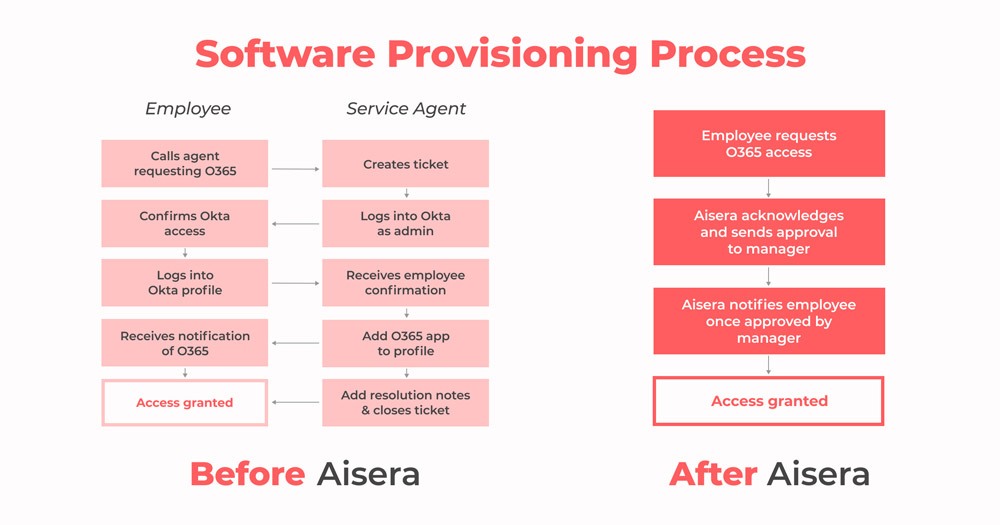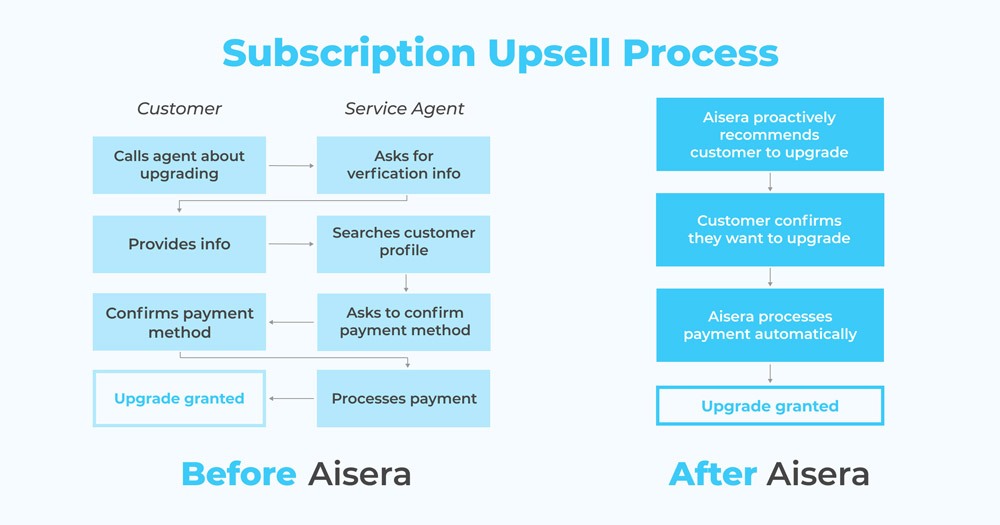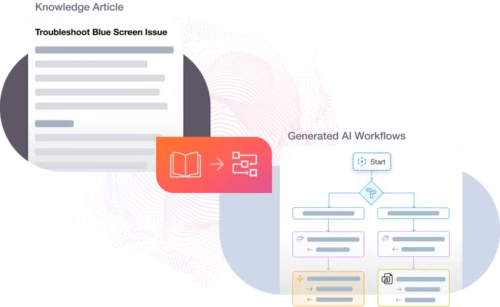Introduction to AI Workflows
Regardless of industry or size, AI Workflows are changing the game for enterprise service delivery. Traditional automation follows rigid rules, AI Workflows use artificial intelligence to execute business tasks with flexibility and context.
But the real competitive advantage now lies in Agentic AI. This goes beyond task execution to autonomous decision making, where systems act as independent agents that “think” through problems.
To do this, organizations use AI workflows orchestration, a high-level strategic process that coordinates the underlying models, agents, data pipelines, and systems. In short: Automation handles the individual tasks, agentic orchestration provides the autonomy to solve them, and orchestration manages the whole ecosystem to make it all work seamlessly.
What is AI Workflow Automation?
AI Workflow Automation is the process of integrating artificial intelligence into business operations to automate and optimize specific tasks or entire sequences of work.
Unlike traditional automation (RPA), which breaks if a rule is violated, AI-driven automation uses machine learning and Agentic AI to understand context, learn from historical data, and make intelligent decisions in real-time. The goal is to evolve from “doing” tasks to “solving” them, handling complex, repetitive work with greater speed and accuracy than human agents or rule-based bots.
Think of it as upgrading from a basic calculator to a proactive digital analyst. A calculator waits for your input to perform a single equation; an AI workflow analyzes the entire spreadsheet, identifies trends, and autonomously drafts a summary email to stakeholders.
Core Capabilities of AI Workflows
Key capabilities of modern AI workflow automation include:
- Autonomous Task Execution (Agentic AI): unlike basic scripts, Agentic AI possesses the ability to reason and plan. It liberates employees from cognitive load by autonomously executing multi-step goals such as resolving complex customer disputes or negotiating supplier terms without requiring human intervention at every decision node.
- Intelligent Support Experiences: In IT and customer service, AI workflows utilize Natural Language Understanding (NLU) to go beyond scripted responses. These workflows understand user intent, provide instant resolutions, and intelligently route complex issues to the specific human specialist best equipped to solve them.
- Sales & Marketing Streamlining: AI agents act as force multipliers by automating lead scoring, drafting hyper-personalized outreach sequences at scale, and analyzing sentiment from customer feedback to provide sales teams with actionable, data-driven insights.
- Predictive Maintenance: In manufacturing and logistics, AI models analyze live sensor data to predict component failures before they occur. The workflow then automatically triggers maintenance tickets, orders necessary parts, and schedules technicians to prevent costly downtime.
- Error Reduction & Compliance: By training on vast historical datasets, AI automation minimizes human error in routine, high-stakes processes like invoice processing or regulatory compliance checks, ensuring consistent quality and audit readiness.
How Does AI Workflow Automation Work?
At its heart, an AI workflow automation is an intelligent loop that turns data into action. The high level steps are:
- Trigger & Data Collection: The workflow starts when a specific event happens, like a new email arrives or a form is submitted. The system then collects all the data needed for the task.
- AI Analysis & Decision: This is where the magic happens. The data is fed into a machine learning model, which analyses it to make a prediction or classification (e.g., is this email urgent? Is this transaction fraudulent?).
- Automated Action & Output: Based on the AI’s decision, the workflow takes a specific action, like routing the urgent email to a manager or flagging the transaction for review.
- Feedback Loop & Improvement: In many advanced workflows, the output of the action is recorded and used to retrain the AI model over time so it gets better and better.
Core Components of an AI Workflow
An AI workflow is more than just a single piece of software; it’s an ecosystem of interconnected components working in concert to deliver an intelligent outcome. Think of it like a highly efficient digital assembly line.
Here are the key components that make it all work:
1. Data Collection and Preparation
This is the foundation. Before any AI can make a decision, it needs high-quality information. This component is responsible for gathering data from various sources (like CRMs, emails, databases, and documents), cleaning it up, and formatting it so the AI model can understand it.
- Analogy: This is the prep station in a kitchen. A chef can’t cook a great meal with messy or low-quality ingredients. This component ensures the AI is working with the best “ingredients” possible.
2. AI Algorithms & Machine Learning Models
This is the “brain” of the operation. The machine learning model is the algorithm that has been trained to find patterns, make predictions, and classify information. It’s the part that analyzes the prepared data and produces an intelligent insight.
- Example: In a customer support workflow, the model analyzes the text of an incoming ticket and predicts its category, such as “Billing Inquiry,” “Technical Support,” or “Password Reset.”
3. Natural Language Processing (NLP)
NLP is a specialized type of AI that acts as a universal translator between humans and machines. Since much of business data is “unstructured” (like emails, chat logs, and documents), NLP enables the workflow to read, understand the context, and even gauge the sentiment of human language.
- Example: NLP is what allows the model to understand that the phrases “my invoice is wrong” and “you overcharged me” both belong to the “Billing Inquiry” category.
4. Automation Triggers and Conditions
A workflow doesn’t run constantly; it needs a “start button.” Triggers are specific events or conditions that initiate the workflow. This ensures the process runs exactly when it’s needed.
- Example: The trigger for a support workflow could be the moment a new email arrives in the support@company.com inbox or when a customer submits a ticket through a web portal.
5. Workflow Orchestration Engine
If the AI model is the brain, the orchestration engine is the project manager or the conductor of the orchestra. It manages the entire sequence of tasks, telling each component what to do and when to do it. It ensures data flows correctly from one step to the next and handles any dependencies or error logic.
- Example: The orchestration engine makes sure that after a ticket is classified, it is then routed to the correct agent’s queue.
6. Integration Layer (APIs)
Most companies use dozens of different software applications that don’t naturally speak to each other. The integration layer, powered by Application Programming Interfaces (APIs), acts as the messenger service that connects these disparate systems.
- Example: An API is what allows the workflow to take the ticket details from your email system (like Outlook) and use them to automatically create a new ticket in your support platform (like Zendesk or Jira).
7. AI Agents
AI Agents are the “digital employees” that execute the tasks. An autonomous agent is a piece of software that uses the AI’s decision to perform an action autonomously. This is similar to an advanced chatbot interacting with a user, a bot updating a database, or an RPA bot filling out a form.
- Example: After a ticket is classified and routed, an AI agent could send an automated reply to the customer: “Thanks for contacting us! We’ve identified your issue as a billing inquiry and have routed it to the correct team.”
AI Workflow vs. Traditional Automation: What's the Difference?
While both AI workflows and traditional automation (like Robotic Process Automation – RPA) aim to increase efficiency, they operate on fundamentally different principles. Traditional automation is about following orders, while AI automation is about making decisions.
In short, traditional automation is perfect for simple, predictable, and repetitive tasks. AI workflows are built to handle complex, unpredictable processes that require a degree of judgment and learning.
| Feature | Traditional Automation (RPA) | AI Workflow |
| Core Logic | Rule-Based: Follows a pre-programmed script. If X happens, do Y. | Data-Driven: Uses patterns and context to make decisions. |
| Decision-Making | Executes commands. | Makes predictions and judgments. |
| Data Handling | Primarily handles structured data (e.g., forms, spreadsheets). | Manages both structured and unstructured data (e.g., emails, images, voice). |
| Adaptability | Static. Requires a developer to change the rules. | Dynamic. Can learn and adapt to new information over time. |
| Example | A bot that copies data from a spreadsheet to a CRM system. | A system that reads customer emails, understands their intent, and routes them to the correct department. |
AI Workflow Automation vs. Orchestration: A Deeper Dive
Within the world of AI workflows, “automation” and “orchestration” are two terms that are often used together, but they describe different layers of the process. Understanding the difference is key to scaling AI in an organization.
AI Workflow Automation
Automation focuses on a specific task. It’s the act of using an AI model to make a single step or a small sequence of steps in an intelligent process.
- Example: An AI automation could be a model that reads an invoice, extracts the vendor name and amount, and checks it against a purchase order. It’s one smart job.
AI Workflow Orchestration
Orchestration focuses on the entire end-to-end system. It’s the process of coordinating multiple automated tasks, data pipelines, different software systems, and even human inputs to achieve a larger business goal.
- Example: AI orchestration would manage the entire invoice process:
- It ingests the invoice from an email.
- It triggers the AI automation to extract the data.
- It pushes the extracted data to the finance software for approval.
- If approved, it triggers another system to schedule the payment.
- It archives the invoice in a separate storage system.
The easiest way to think about it is with an orchestra analogy. Automation is the skilled violinist playing their part perfectly. Orchestration is the conductor, ensuring the entire orchestra, violins, cellos, percussion, and horns play together at the right time to create a beautiful symphony. You need both to succeed at scale.
Key Benefits of AI Workflow Tools and Applications
AI Workflow Orchestration streamlines everything. It’s as easy as that. AI Workflow orchestration proactively and autonomously enables users to complete actions, serves knowledge, and more. Aided by AI, users are no longer bogged down in a cycle of endless conversations with service agents and can spend their valuable time delivering meaningful tasks.
Additionally, AI Workflow Orchestration addresses the error-prone nature of traditional enterprise workflows. The human factor in conventional enterprise workflows can leave too much room for error. Agentic AI solutions for enterprise workflows enter both speed and accuracy into the picture. It doesn’t get any better than that. Organizations can now use AI Orchestration tools to do all the heavy lifting by offloading tasks and actions from service agents and sweeping through hundreds and thousands of user requests.
AI Workflow Orchestration also opens up the doors in these processes for extensive data analysis and insights. The AI-driven solution monitors applications to provide detailed reports and unique insights into various areas of the organization. For example, organizations can utilize this data to track or better understand ROI, providing increased transparency and highlighting potential areas or departments that could benefit from automation next.
The icing on the cake is that these organizations simultaneously improve processes, user experience, and employee engagement while saving on costs. AI Workflow Orchestration drives strong ROI by drastically less time-consuming errors, improving service agent productivity, and speeding up ticket and request remediation.
All this sounds a little too good to be true, right? Wrong. While the workflow automation benefits are impressive and, at times, may seem unbelievable, the fact of the matter is that AI is making huge strides in every industry. There has been massive progress in the technology that improves the AI itself or supports growing AI functionality, and we are beginning to see just how much of an impact it has on our daily lives.
In summary, when you consider Artificial Intelligence Workflow Automation, first identify your goals—are they cost-related? Is engagement and employee satisfaction related? Efficiency-related?
Watch this video to see how advanced agentic AI streamlines workflows across HR, IT, and CX systems.
Real-World Examples of AI Workflows
AI workflows are not a future concept; they are actively transforming business functions today. Here are some practical examples of how different departments use them.
Customer Service
- Intelligent Ticket Triage: When a customer support request arrives via email, an AI workflow analyzes the text to determine its topic (e.g., billing, technical issue), urgency, and sentiment. It then automatically routes the ticket to the best-equipped agent or department, dramatically speeding up response times.
Sales & Marketing
- Automated Lead Scoring: Instead of manually qualifying leads, an AI workflow can analyze a new lead’s data (company size, job title, website activity) against historical data of successful customers. It then assigns a “lead score,” automatically routing high-potential leads directly to the sales team for immediate follow-up.
Human Resources (HR)
- Resume Screening & Candidate Matching: When a new job is posted, an AI workflow can scan hundreds of incoming resumes, extract key skills and experience, and score each candidate based on their fit for the role. This provides recruiters with a pre-vetted shortlist of the top candidates to interview.
Finance & Operations
- Automated Invoice Processing: An AI workflow can automatically extract data from invoices received in various formats (PDF, email, scans). It then validates the information against purchase orders, flags any discrepancies, and, if everything matches, forwards the invoice for payment approval—all without manual data entry.
Application of Aisera AI Workflow Tool
Now that we’ve gone through the basics of the Workflow AI tool, how can businesses leverage this kind of technology in their everyday operations? The possibilities are endless.
Bringing back to the previous example of AI application provisioning, it can enter the equation by just automating the whole process altogether. Instead of a convoluted, back-and-forth process between the employee and service agent, a good AI Workflow Orchestration will only require the employee to request access to the application, and the AI will take care of the rest. Take a look at the diagram below.

A proper AI Workflow Orchestration tool simplifies the process by eliminating extra steps, reducing time spent by the employee to get what they need.
That’s an example of an internal process automated by AI workflow, but how does deployment automation of an external process look? Subscription upselling is a large part of how a business generates revenue; however, a traditional subscription upselling and upgrading process can be overly complicated.
In line with the previous example, today’s subscription upselling process is outdated, requiring back-and-forth interaction between the customer and service agent.
AI Workflow Orchestration streamlines the subscription upselling process by doing all the heavy lifting. The AI can recommend a subscription upgrade, and if the customer confirms the recommendation, the AI will take care of the rest of the process. It’s as easy as that. Take a look at the diagram below.

How to Implement an AI Workflow: A 5-Step Guide
It’s always challenging to choose the right AI solutions and implement them in an existing system. So, let’s get started by identifying your needs. Does your organization need an internal or external-facing solution? Are there any bottlenecks or gaps in your organization’s workflows? Next, look for the solution that’s right for you. A good AI Workflow builder will effectively reduce your costs and time spent on tasks and actions, and allow you to improve service agent productivity.
Getting started with AI workflows doesn’t have to be scary. Follow this framework and you’ll be fine.
- Find the Right Use Case: Look for tasks that are repetitive, data-heavy, and have clear decision points. Good candidates are for invoice processing, customer ticket routing, or lead scoring. You want to solve a specific business problem, not just implement AI for the sake of it.
- Get Your Data: AI is only as good as the data it’s trained on. Identify the data sources for your workflow and make sure the data is clean, labeled, and accessible. This is often the most time-consuming but critical step.
- Choose Your Tools and Models: Do you build a custom AI model or use a pre-built model from a vendor? Choose a workflow automation platform that can talk to your existing systems (CRMs, ERPs) and manage the process from end to end.
- Build and Test the Workflow: Map out the steps of your process in the automation tool. Configure the triggers, connect the AI model via API and define the final actions. Run the workflow with test data to find and fix any errors before you go live.
- Deploy, Monitor and Iterate: Once live, monitor the workflow. Track key metrics like accuracy, processing time, and cost savings. Use this feedback to retrain your model and refine the workflow for continuous improvement.


